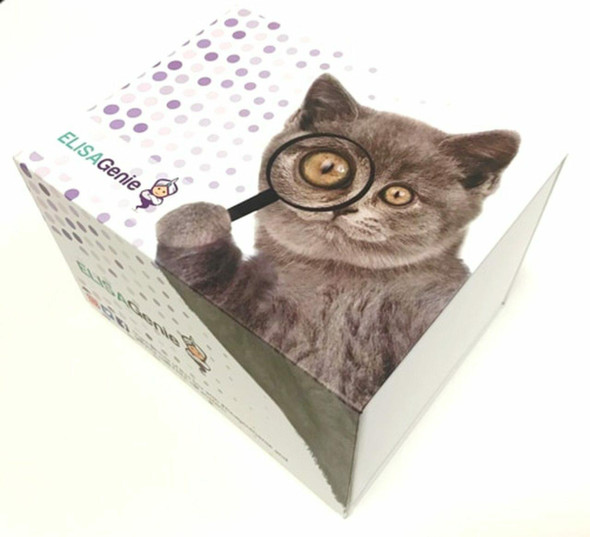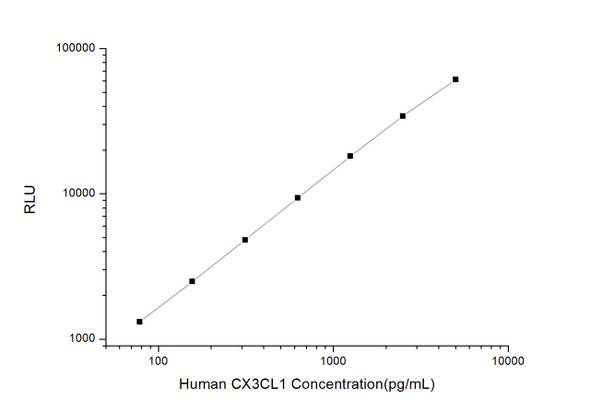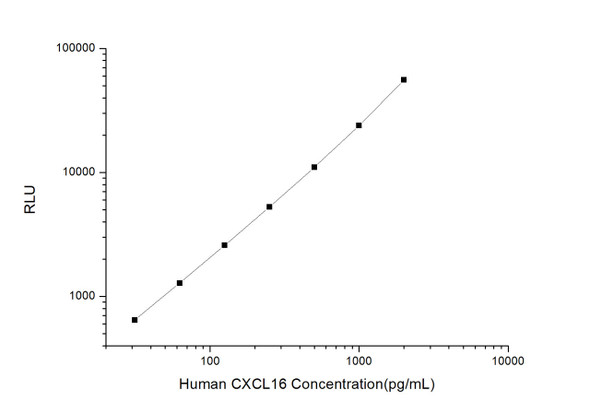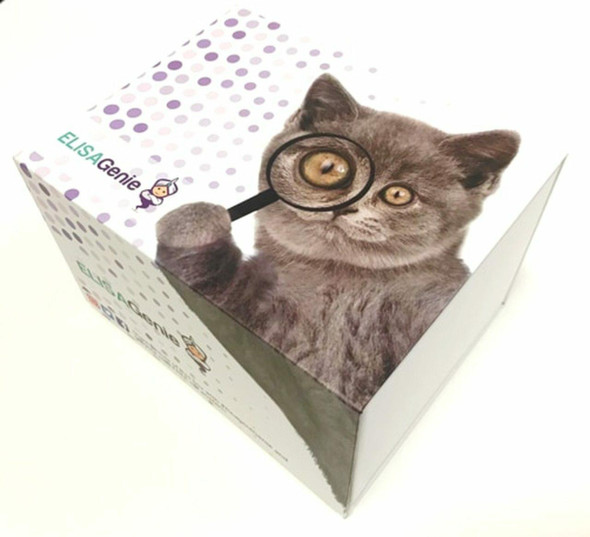Human Immunology ELISA Kits 11
Human CCL14 (Chemokine C-C-Motif Ligand 14) CLIA Kit (HUES00449)
- SKU:
- HUES00449
- Product Type:
- ELISA Kit
- ELISA Type:
- CLIA Kit
- Size:
- 96 Assays
- Sensitivity:
- 7.5pg/mL
- Range:
- 12.5-800pg/mL
- ELISA Type:
- Sandwich
- Reactivity:
- Human
- Sample Type:
- Serum, plasma and other biological fluids
Description
| Assay type: | Sandwich |
| Format: | 96T |
| Assay time: | 4.5h |
| Reactivity: | Human |
| Detection method: | Chemiluminescence |
| Detection range: | 12.50-800 pg/mL |
| Sensitivity: | 7.50 pg/mL |
| Sample volume: | 100µL |
| Sample type: | Serum, plasma and other biological fluids |
| Repeatability: | CV < 15% |
| Specificity: | This kit recognizes Human CCL14 in samples. No significant cross-reactivity or interference between Human CCL14 and analogues was observed. |
This kit uses Sandwich-CLIA as the method. The micro CLIA plate provided in this kit has been pre-coated with an antibody specific to Human CCL14. Standards or samples are added to the appropriate micro CLIA plate wells and combined with the specific antibody. Then a biotinylated detection antibody specific for Human CCL14 and Avidin-Horseradish Peroxidase (HRP) conjugate are added to each micro plate well successively and incubated. Free components are washed away. The substrate solution is added to each well. Only those wells that contain Human CCL14, biotinylated detection antibody and Avidin-HRP conjugate will appear fluorescence. The Relative light unit (RLU) value is measured spectrophotometrically by the Chemiluminescence immunoassay analyzer. The RLU value is positively associated with the concentration of Human CCL14. The concentration of Human CCL14 in the samples can be calculated by comparing the RLU of the samples to the standard curve.
| UniProt Protein Function: | CCL14: Has weak activities on human monocytes and acts via receptors that also recognize MIP-1 alpha. It induced intracellular Ca(2+) changes and enzyme release, but no chemotaxis, at concentrations of 100-1,000 nM, and was inactive on T-lymphocytes, neutrophils, and eosinophil leukocytes. Enhances the proliferation of CD34 myeloid progenitor cells. The processed form HCC-1(9-74) is a chemotactic factor that attracts monocytes eosinophils, and T-cells and is a ligand for CCR1, CCR3 and CCR5. Belongs to the intercrine beta (chemokine CC) family. 2 isoforms of the human protein are produced by alternative splicing. |
| UniProt Protein Details: | Protein type:Secreted, signal peptide; Motility/polarity/chemotaxis; Secreted Chromosomal Location of Human Ortholog: 17q12 Cellular Component: extracellular space Molecular Function:chemokine activity Biological Process: cellular calcium ion homeostasis; positive regulation of cell proliferation; immune response |
| NCBI Summary: | This gene, chemokine (C-C motif) ligand 14, is one of several CC cytokine genes clustered on 17q11. 2. The CC cytokines are secreted proteins characterized by two adjacent cysteines. The cytokine encoded by this gene induces changes in intracellular calcium concentration and enzyme release in monocytes. Multiple transcript variants encoding different isoforms have been found for this gene. Read-through transcripts are also expressed that include exons from the upstream cytokine gene, chemokine (C-C motif) ligand 15, and are represented as GeneID: 348249. [provided by RefSeq, Dec 2009] |
| UniProt Code: | Q16627 |
| NCBI GenInfo Identifier: | 14589959 |
| NCBI Gene ID: | 6358 |
| NCBI Accession: | NP_116738. 1 |
| UniProt Secondary Accession: | Q16627,Q13954, E1P649, E1P650, |
| UniProt Related Accession: | Q16627 |
| Molecular Weight: | ~9. 5 kDa |
| NCBI Full Name: | C-C motif chemokine 14 isoform 2 |
| NCBI Synonym Full Names: | chemokine (C-C motif) ligand 14 |
| NCBI Official Symbol: | CCL14 |
| NCBI Official Synonym Symbols: | CC-1; CC-3; CKB1; MCIF; NCC2; SY14; HCC-1; HCC-3; NCC-2; SCYL2; SCYA14; HCC-1(1-74); HCC-1/HCC-3 |
| NCBI Protein Information: | C-C motif chemokine 14 |
| UniProt Protein Name: | C-C motif chemokine 14 |
| UniProt Synonym Protein Names: | Chemokine CC-1/CC-3; HCC-1/HCC-3 |
| Protein Family: | C-C motif chemokine |
| UniProt Gene Name: | CCL14 |
| UniProt Entry Name: | CCL14_HUMAN |
As the RLU values of the standard curve may vary according to the conditions of the actual assay performance (e. g. operator, pipetting technique, washing technique or temperature effects), the operator should establish a standard curve for each test. Typical standard curve and data is provided below for reference only.
| Concentration (pg/mL) | RLU | Average | Corrected |
| 800 | 48005 57279 | 52642 | 52616 |
| 400 | 21378 22090 | 21734 | 21708 |
| 200 | 9812 9604 | 9708 | 9682 |
| 100 | 4194 4910 | 4552 | 4526 |
| 50 | 2304 2072 | 2188 | 2162 |
| 25 | 1078 1042 | 1060 | 1034 |
| 12.50 | 506 512 | 509 | 483 |
| 0 | 25 27 | 26 | -- |
Precision
Intra-assay Precision (Precision within an assay): 3 samples with low, mid range and high level Human CCL14 were tested 20 times on one plate, respectively.
Inter-assay Precision (Precision between assays): 3 samples with low, mid range and high level Human CCL14 were tested on 3 different plates, 20 replicates in each plate.
| Intra-assay Precision | Inter-assay Precision | |||||
| Sample | 1 | 2 | 3 | 1 | 2 | 3 |
| n | 20 | 20 | 20 | 20 | 20 | 20 |
| Mean (pg/mL) | 39.77 | 127.62 | 317.92 | 38.63 | 118.11 | 324.41 |
| Standard deviation | 3.47 | 11.29 | 22.00 | 3.64 | 9.73 | 26.80 |
| C V (%) | 8.73 | 8.85 | 6.92 | 9.42 | 8.24 | 8.26 |
Recovery
The recovery of Human CCL14 spiked at three different levels in samples throughout the range of the assay was evaluated in various matrices.
| Sample Type | Range (%) | Average Recovery (%) |
| Serum (n=5) | 89-103 | 95 |
| EDTA plasma (n=5) | 89-102 | 95 |
| Cell culture media (n=5) | 86-100 | 91 |
Linearity
Samples were spiked with high concentrations of Human CCL14 and diluted with Reference Standard & Sample Diluent to produce samples with values within the range of the assay.
| Serum (n=5) | EDTA plasma (n=5) | Cell culture media (n=5) | ||
| 1:2 | Range (%) | 93-107 | 102-118 | 100-113 |
| Average (%) | 100 | 110 | 107 | |
| 1:4 | Range (%) | 92-107 | 92-106 | 94-110 |
| Average (%) | 99 | 98 | 102 | |
| 1:8 | Range (%) | 101-115 | 94-106 | 90-102 |
| Average (%) | 108 | 101 | 95 | |
| 1:16 | Range (%) | 94-106 | 100-113 | 94-108 |
| Average (%) | 99 | 105 | 102 |
An unopened kit can be stored at 4°C for 1 month. If the kit is not used within 1 month, store the items separately according to the following conditions once the kit is received.
| Item | Specifications | Storage |
| Micro CLIA Plate(Dismountable) | 8 wells ×12 strips | -20°C, 6 months |
| Reference Standard | 2 vials | |
| Concentrated Biotinylated Detection Ab (100×) | 1 vial, 120 µL | |
| Concentrated HRP Conjugate (100×) | 1 vial, 120 µL | -20°C(shading light), 6 months |
| Reference Standard & Sample Diluent | 1 vial, 20 mL | 4°C, 6 months |
| Biotinylated Detection Ab Diluent | 1 vial, 14 mL | |
| HRP Conjugate Diluent | 1 vial, 14 mL | |
| Concentrated Wash Buffer (25×) | 1 vial, 30 mL | |
| Substrate Reagent A | 1 vial, 5 mL | 4°C (shading light) |
| Substrate Reagent B | 1 vial, 5 mL | 4°C (shading light) |
| Plate Sealer | 5 pieces | |
| Product Description | 1 copy | |
| Certificate of Analysis | 1 copy |
- Set standard, test sample and control (zero) wells on the pre-coated plate and record theirpositions. It is recommended to measure each standard and sample in duplicate. Note: addall solutions to the bottom of the plate wells while avoiding contact with the well walls. Ensuresolutions do not foam when adding to the wells.
- Aliquot 100µl of standard solutions into the standard wells.
- Add 100µl of Sample / Standard dilution buffer into the control (zero) well.
- Add 100µl of properly diluted sample (serum, plasma, tissue homogenates and otherbiological fluids. ) into test sample wells.
- Cover the plate with the sealer provided in the kit and incubate for 90 min at 37°C.
- Aspirate the liquid from each well, do not wash. Immediately add 100µL of BiotinylatedDetection Ab working solution to each well. Cover the plate with a plate seal and gently mix. Incubate for 1 hour at 37°C.
- Aspirate or decant the solution from the plate and add 350µL of wash buffer to each welland incubate for 1-2 minutes at room temperature. Aspirate the solution from each well andclap the plate on absorbent filter paper to dry. Repeat this process 3 times. Note: a microplatewasher can be used in this step and other wash steps.
- Add 100µL of HRP Conjugate working solution to each well. Cover with a plate seal andincubate for 30 min at 37°C.
- Aspirate or decant the solution from each well. Repeat the wash process for five times asconducted in step 7.
- Add 100µL of Substrate mixture solution to each well. Cover with a new plate seal andincubate for no more than 5 min at 37°C. Protect the plate from light.
- Determine the RLU value of each well immediately.






